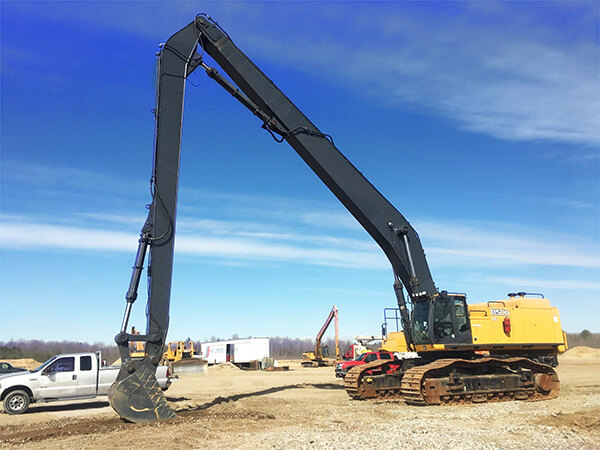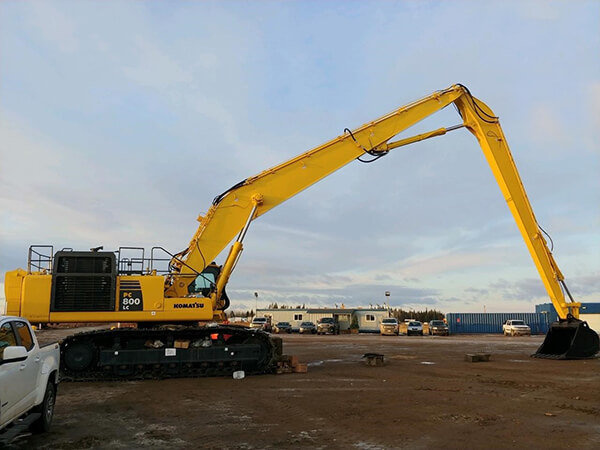Excavators are essential pieces of heavy machinery used in construction, mining, and other industries for various earthmoving tasks. With their versatility and power, excavators equipped with long front booms have become increasingly popular in recent years. The extended reach provided by these booms allows operators to access hard-to-reach areas and perform specialized tasks. However, to ensure safe operation and minimize potential risks, it is crucial to understand and adhere to proper protocols. This article will explore the safe use of excavator long front boom, highlighting key considerations and best practices.

Understanding Excavator Long Front Booms
An excavator long front boom, also known as a high reach or long reach boom, is an attachment that extends the reach of the excavator’s arm. It typically consists of a boom, stick, and bucket, allowing the operator to work at greater distances or heights than a standard excavator. These booms are commonly used for tasks such as dredging, deep excavation, demolition, and reach applications.
Safety Considerations
- Equipment Inspection: Before commencing any work, conduct a thorough inspection of the excavator and the long front boom. Check for any signs of damage, leaks, or loose parts. Ensure that all safety features, such as guards and safety locks, are in proper working condition.
- Operator Training: Only trained and authorized personnel should operate excavators with long front booms. Operators should have comprehensive knowledge of the machine’s controls, safety procedures, and limitations. Regular training and refresher courses are essential to keep skills up to date.
- Site Evaluation: Evaluate the work site thoroughly to identify potential hazards such as overhead power lines, unstable ground, or underground utilities. Determine if the soil or ground conditions can support the machine’s weight and the extended reach of the long front boom.
- Stability and Ground Support: Excavators with long front booms have an altered center of gravity. It is crucial to ensure the machine’s stability by placing it on firm, level ground. Consider using additional support measures like outriggers or stabilizers to enhance stability and prevent tipping.
- Load Capacity: Be aware of the excavator’s load capacity limitations when using a long front boom. Overloading the machine can compromise stability and increase the risk of accidents. Consult the manufacturer’s specifications and adhere to the recommended load capacities for safe operation.
- Communication and Signaling: Establish clear communication protocols between the operator and ground personnel. Use standardized hand signals or radio communication devices to relay instructions effectively. This ensures proper coordination and minimizes the potential for accidents.

Best Practices for Safe Operation
- Plan and Preparations: Develop a comprehensive plan for the task at hand. This should include a detailed assessment of the work site, identification of potential hazards, and a step-by-step approach to ensure safe and efficient operation.
- Personal Protective Equipment (PPE): All personnel involved in the operation, including the operator and ground crew, should wear appropriate PPE. This may include high-visibility clothing, safety helmets, steel-toed boots, and safety glasses. PPE helps protect against potential hazards such as falling debris or flying particles.
- Smooth and Controlled Movements: When operating an excavator with a long front boom, it is crucial to maintain smooth and controlled movements. Avoid sudden jerks or excessive swinging, as these actions can destabilize the machine and compromise safety.
- Proper Bucket Positioning: Ensure the bucket or attachment is correctly positioned during operation. Improper bucket positioning can lead to uneven loads, loss of control, or tipping of the machine. Regularly inspect the bucket and connections for wear or damage.
- Regular Maintenance: Adhere to a strict maintenance schedule for the excavator and the long front boom. Regularly inspect and lubricate all components, including hydraulic systems, pins, and bushings. Address any signs of wear or damage promptly to prevent equipment failure during operation.
- Avoid Overreaching: Although the long front boom provides extended reach, operators must exercise caution and avoid overreaching. Operating the machine beyond its recommended reach or capacity can compromise stability and increase the risk of accidents. Be aware of the boom’s limitations and maintain a safe working distance.
- Weather Conditions: Take weather conditions into account when operating an excavator with a long front boom. High winds, heavy rain, or slippery surfaces can impact stability and increase the risk of accidents. Consider postponing work during adverse weather conditions or take additional safety measures, such as using stabilizing devices.
- Secure the Work Area: Ensure that the work area is properly secured and barricaded to prevent unauthorized access. Clear the area of bystanders and ensure that everyone involved in the operation is at a safe distance from the machine and the work zone.
- Emergency Procedures: Establish emergency procedures and communicate them to all personnel involved. Ensure that everyone knows how to shut down the machine in case of an emergency, and provide first aid training to address potential injuries promptly.
- Post-Operation Checks: After completing the work, conduct post-operation checks on the excavator and the long front boom. Look for any signs of damage or wear that may have occurred during the operation. Address any maintenance or repair needs before the next use.

Conclusion
Excavators with long front booms offer enhanced reach and versatility, allowing operators to tackle specialized tasks. However, ensuring safe usage is paramount to prevent accidents and protect personnel. By adhering to proper safety protocols, conducting thorough inspections, and implementing best practices, operators can minimize risks and optimize productivity. Remember to prioritize operator training, regular maintenance, and effective communication between the operator and ground personnel. With a safety-conscious approach, the safe use of excavator long front boom can be achieved, promoting efficient and secure operations in various industries.